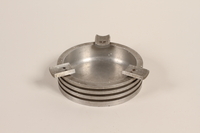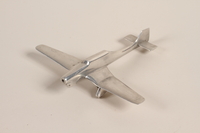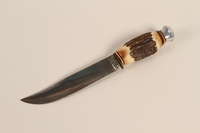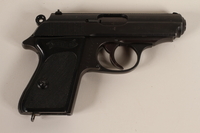Overview
- Brief Narrative
- Zeiss, porro prism binoculars found by Lt. Milton Shurr, a Jewish American soldier, at the recently liberated Buchenwald concentration camp in April-May 1945 in Germany. First Lt. He found them in workroom where binoculars were assembled at the camp. Shurr, a member of the Civil Affairs unit, assisted in planning for D-Day, June 6, 1944. He landed on Omaha Beach soon after the invasion to organize supplies, then was placed with the 1st Army Displaced Persons Team. On April 11, 1945, the US Third Army liberated Buchenwald. Command of the camp was transferred to the 1st Army, which was responsible for establishing order, improving camp conditions, and caring for the inmates. Shurr worked 16 hour days trying to find food for 15,000 starving survivors. He later was sent to Bavaria as a health welfare officer to assist with the re-establishment of schools, hospitals, and other social services by the US Military occupation government. In 1949, he declined a permanent position and returned to the US.
- Date
-
found:
1945 April-1945 May
- Geography
-
found:
Buchenwald (Concentration camp);
Weimar (Thuringia, Germany)
- Credit Line
- United States Holocaust Memorial Museum Collection, Gift of Milton L. Shurr
- Markings
- back, left end cap, engraved, white paint : CARL ZEISS / JENA
back, right end cap, engraved, white paint : Dienstglas / 6 X 30 / 2023933 / H/6400 / blc + [service glass]
back, eyepieces, metal ring, engraved, white paint : 5 - 0 + 5
back, pivot end cap, engraved : 70 60 [?] - Contributor
-
Subject:
Milton L. Shurr
Manufacturer: Carl Zeiss (Firm : 1846)
- Biography
-
Milton Shurr was born on January 28, 1911, in Rochester, NY, to Mr and Mrs. Harry Shurr. On June 3, 1941, he married Muriel Friedman, from New York City. That year, motivated by news about the persecution of Jews in Europe, including news from correspondents about the camps, Milton joined the field staff of the Council of Jewish Federations and Welfare Fund. He moved from Minneapolis, MN, to Oklahoma City, OK, to head the Fund. He transitioned from being a program organizer in public health to arranging regional conferences to fundraise and to inform US citizens of what was happening abroad.
The United States entered World War II on December 8, 1941, following the attack on Pearl Harbor. Milton was drafted into the US Army and enrolled in Officer's Candidate School. Corporal Shurr was then sent to military government school to be trained to rebuild postwar Germany. First Lieutenant Shurr and the rest of his class were deployed to Great Britain in February 1944. They assisted in the preparations for Operation Overlord, set for June 6, 1944. He was recruited from the Quartermasters Corp by the Army's Department of Civilian Affairs. Slated to deploy one week after D-Day, their departure was delayed to send more fighting troops. They then landed on Omaha Beach near Isigny. Milton was stationed with the 1st Army. He was assigned to collect medical or other supplies dropped on the beach and then throughout France.
In October 1944, Milton was placed with the 1st Army Displaced Persons Team in Vervier, Belgium, and was in Malmady during the Battle of the Bulge. He continued to travel widely with a driver searching for supplies. They drove through combat territory and were often bombed. Around January 1945, Milton fell ill with hepatitis and was sent to England to recover. He returned to his unit in Germany the day after Patton's 3rd Army liberated Buchenwald concentration camp on April 11, 1945. Buchenwald was then transferred to the command of the 1st Army, which had the task of creating a stable, orderly environment out of the chaotic conditions found at the camp. Camp conditions were in turmoil; soldiers were looting and corpses were piled everywhere. Milton was faced with the enormous task of caring for the approximately 15,000 surviving prisoners, all men and boys, who were dying at a rate of 300 persons a day. Milton met daily with about fifteen capos who were his eyes and ears in the camp and his main source of information about what the former prisoners needed. He was in charge of supplies and worked with a team of three-four officers, six enlisted men, four-five liaison foreign officers, two Russian women who were the cooks, and an assortment of local assistants and mechanics. He worked 16 hour days trying to find enough food to keep the inmates alive. They scoured the surrounding country for supplies and obtained most of their food supplies by confiscating them from German civilians. Cigarettes were used as currency. The Army had obtained nearly a ton of Turkish cigarettes from German supplies. He paid inmates in cigarettes to load and unload trucks. About forty Polish prisoners were recruited to find him transport. They stole two diesel trucks from German locals, and painted them olive drab, with false ordnance numbers.
Milton also assisted with the repatriation efforts. Western Europeans were repatriated first. Eastern Europeans were given the choice of returning home or moving to the West. Milton was a liaison with the Red Cross and the Joint Distribution Committee, who organized the repatriation and resettlement of the survivors. There were about 700-1000 boys in the camp and Milton worked with both groups to get them individualized attention. Most were resettled in Palestine. As prisoners left, they were replaced by new ones who wanted to move West. The camp gradually transformed into a displaced persons camp. Horrified by the lack of the value of life in the camp, Milton tried to preserve and collect evidence of the crimes committed there for military investigators. Milton remained at Buchenwald until July 1, 1945, when the camp was transferred to the Soviets, who turned it back into a prison camp. Milton was reclassified as a health welfare officer, part of the military occupation government. He was stationed in Bavaria, where he worked to reopen schools, hospitals, banks, and other social services. In 1949, Milton declined a permanent position with the military in Bavaria as he wished to return to his wife. After demobilization in New Jersey, Milton and his family relocated to Chicago where he worked in health planning. Milton was unable to speak of Buchenwald for many years. Supported by his wife Muriel’s belief that he had a responsibility to share what he had witnessed, after forty years, Milton began to share his experiences. Milton, age 98, died in 2009. His wife Muriel died a month later.
Physical Details
- Language
- German
- Classification
-
Personal Equipment and Supplies
- Category
-
Optical equipment and supplies
- Object Type
-
Binoculars (lcsh)
- Physical Description
- Small binoculars with 2 offset pairs of tubes housed in black painted, silver colored metal triangular casing covered with black leatherette. At the front of each casing, a large, clear glass objective lens is set into the raised, black painted metal end of the front tube. At the back, a small, clear glass ocular lens is set into the end of the back tube. A threaded black plastic eyecup is screwed around the lens. A ridged, black plastic focusing ring with engraved, white painted numbers is set around the back tube. When the ring is turned, the tube extends or retracts. The casings are connected by an adjustable frame with 2 horizontal, curved bridges and a central vertical tube with engraved numbers on the back end. A small, rectangular bracket protrudes from the underside of each casing and a brown leather strap is tied to the casing brackets.
- Dimensions
- overall: Height: 2.750 inches (6.985 cm) | Width: 5.500 inches (13.97 cm) | Depth: 4.250 inches (10.795 cm)
- Materials
- overall : metal, plastic, leather, glass, paint
Rights & Restrictions
- Conditions on Access
- No restrictions on access
- Conditions on Use
- No restrictions on use
Keywords & Subjects
- Topical Term
- Ex-concentration camp inmates--Germany--Weimar (Thuringia)--Biography. Jewish soldiers--United States--Biography. Reconstruction (1939-1951)--Germany--Personal narratives, American. Soldiers--United States--Biography. World War, 1939-1945--Concentration camps--Liberation--Germany--Weimar (Thuringia)--Personal narratives, American. World War, 1939-1945--Personal narratives, American.
Administrative Notes
- Legal Status
- Permanent Collection
- Provenance
- The binoculars were donated to the United States Holocaust Memorial Museum in 1988 by Milton L. Shurr.
- Funding Note
- The cataloging of this artifact has been supported by a grant from the Conference on Jewish Material Claims Against Germany.
- Record last modified:
- 2023-08-25 16:30:25
- This page:
- https://collections.ushmm.org/search/catalog/irn514918
Download & Licensing
In-Person Research
- By Appointment
- Request 21 Days in Advance of Visit
- Plan a Research Visit
- Request to See This Object
Contact Us
Also in Milton L. Shurr collection
The collection consists of an ashtray, binoculars, model airplane, Buchenwald scrip, a hunting knife and sheath, a Walther pistol and sheath, and a watercolor, documents, photographs, and publications relating to the experiences of Milton Shurr, who as a member of the United States 1st Army Displaced Persons Team, arrived to care for prisoners at Buchenwald concentration camp soon after its liberation in April 1945.
Date: 1937-1945

Piston head ashtray made for concentration camp commander found by US military aid worker
Object
Ashtray made from a truck piston head found by Lt. Milton Shurr, a Jewish American soldier, at the recently liberated Buchenwald concentration camp in April-May 1945 in Germany. It is inscribed to Herman Pister, the SS camp commandant, who fled before US troops arrived. He was captured, tried, and sentenced to death, but died before the sentence was carried out. First Lt. Shurr, Civil Affairs Unit, assisted in planning for D-Day, June 6, 1944. He landed on Omaha Beach soon after the invasion to organize supplies, then was placed with the 1st Army Displaced Persons Team. On April 11, 1945, the US Third Army liberated Buchenwald. Command of the camp was transferred to the 1st Army, which was responsible for establishing order, improving camp conditions, and caring for the inmates. Shurr worked 16 hour days trying to find food for 15,000 starving survivors. He later was sent to Bavaria as a health welfare officer to assist with the re-establishment of schools, hospitals, and other social services by the US Military occupation government. In 1949, he declined a permanent position and returned to the US.

Model Stuka airplane made by liberated concentration camp inmate and given to US military aid worker
Object
Model German Stuka bomber presented to Lt. Milton Shurr, a Jewish American soldier, made by a former prisoner at the recently liberated Buchenwald concentration camp. He was told that the models were made for the SS camp officers. First Lt. Shurr, Civil Affairs Unit, assisted in planning for D-Day, June 6, 1944. He landed on Omaha Beach soon after the invasion to organize supplies, then was placed with the 1st Army Displaced Persons Team. On April 11, 1945, the US Third Army liberated Buchenwald. Command of the camp was transferred to the 1st Army, which was responsible for establishing order, improving camp conditions, and caring for the inmates. Shurr worked 16 hour days trying to find food for 15,000 starving survivors. He later was sent to Bavaria as a health welfare officer to assist with the re-establishment of schools, hospitals, and other social services by the US Military occupation government. In 1949, he declined a permanent position and returned to the US.

Solingen hunting knife with sheath presented to US military aid worker by liberated inmates
Object
Hunting knife with stag antler handle and leather sheath presented to Lt. Milton Shurr, a Jewish American soldier, by a former inmate of the recently liberated Buchenwald concentration camp in April-May 1945. First Lt. Shurr assisted in the planning for D-Day, June 6, 1944, and joined the Civil Affairs Unit. He landed on Omaha Beach soon after the invasion to organize medical supplies, then was placed with the 1st Army Displaced Persons Team. On April 11, 1945, the US Third Army liberated Buchenwald. Command of the camp was transferred to the 1st Army, which was responsible for establishing order, improving camp conditions, and caring for the inmates. Shurr worked 16 hour days trying to find enough food for 15,000 starving survivors. He later was sent to Bavaria as a health welfare officer to assist with the re-establishment of schools, hospitals, and other social services by the US Military occupation government. In 1949, he declined a permanent position and returned to the US.

Semi-automatic Walther PPK pistol, holster, and magazines found at a concentration camp by Lt. Milton Shurr
Object
Walther 7.65 semi-automatic pistol, leather holster, and two magazines found by Lt. Milton Shurr, a Jewish American soldier, at the recently liberated Buchenwald concentration camp in April-May 1945 in Germany. This pistol was never fired, but, lighter than a Luger, it was the type used by SS guards at the camp. First Lt. Shurr, Civil Affairs Unit, assisted in planning for D-Day, June 6, 1944. He landed on Omaha Beach soon after the invasion to organize supplies, then was placed with the 1st Army Displaced Persons Team. On April 11, 1945, the US Third Army liberated Buchenwald. Command of the camp was transferred to the 1st Army, which was responsible for establishing order, improving camp conditions, and caring for the inmates. Shurr worked 16 hour days trying to find food for 15,000 starving survivors. He later was sent to Bavaria as a health welfare officer to assist with the re-establishment of schools, hospitals, and other social services by the US Military occupation government. In 1949, he declined a permanent position and returned to the US.
Milton Shurr papers
Document
The papers relate to the liberation of Buchenwald concentration camp by United States troops in 1945.
Book
Object
Copy of Mein Kampf found by Lt. Milton Shurr, a Jewish American soldier, in April 1945 at the recently liberated Buchenwald concentration camp in Germany. It had belonged to one of the SS officers and is signed by the mayor of Trier, Germany and inscribed with best wishes for newlyweds. Shurr was housed in the former officer's barrack. Shurr, Civil Affairs Unit, assisted in planning for D-Day, June 6, 1944. He landed on Omaha Beach soon after the invasion to organize supplies, then was placed with the 1st Army Displaced Persons Team. On April 11, 1945, the US Third Army liberated Buchenwald. Command of the camp was transferred to the 1st Army, which was responsible for establishing order and caring for the inmates. Shurr worked 16 hour days trying to find food for 15,000 starving survivors. He later was sent to Bavaria as a health welfare officer to assist with the re-establishment of schools, hospitals, and other social services by the US Military occupation government. In 1949, he declined a permanent position and returned to the US.
Buchenwald Standort-Kantine camp scrip, 2 Reichsmark, with inscription found by US military aid worker
Object
Inscribed 2 Reichsmark Buchenwald Kantine coupon found by Lt. Milton Shurr, a Jewish American soldier, in April-May 1945 in the recently liberated Buchenwald concentration camp in Germany. First Lt. Shurr, Civil Affairs Unit, assisted in planning for D-Day, June 6, 1944. He landed on Omaha Beach soon after the invasion to organize supplies, then was placed with the 1st Army Displaced Persons Team. On April 11, 1945, the US Third Army liberated Buchenwald. Command of the camp was transferred to the 1st Army, which was responsible for establishing order, improving camp conditions, and caring for the inmates. Shurr worked 16 hour days trying to find food for 15,000 starving survivors. He later was sent to Bavaria as a health welfare officer to assist with the re-establishment of schools, hospitals, and other social services by the US Military occupation government. In 1949, he declined a permanent position and returned to the US.
Watercolor of a mountain and town given to US military aid worker by liberated inmate
Object
Watercolor of a mountainside village painted by an unknown prisoner and presented to Lt. Milton Shurr, a Jewish American soldier, as a sign of friendship and gratitude by another inmate of the recently liberated Buchenwald concentration camp in April-May 1945. The painting was created shortly after liberation. First Lt. Shurr assisted in planning for D-Day, June 6, 1944, and joined the Civil Affairs Unit. He landed on Omaha Beach soon after the invasion to organize supplies, then was placed with the 1st Army Displaced Persons Team. On April 11, 1945, the US Third Army liberated Buchenwald. Command of the camp was transferred to the 1st Army, which was responsible for establishing order, improving camp conditions, and caring for the inmates. Shurr worked 16 hour days trying to find food for 15,000 starving survivors. He later was sent to Bavaria as a health welfare officer to assist with the re-establishment of schools, hospitals, and other social services by the US Military occupation government. In 1949, he declined a permanent position and returned to the US.



